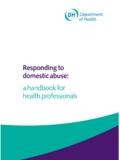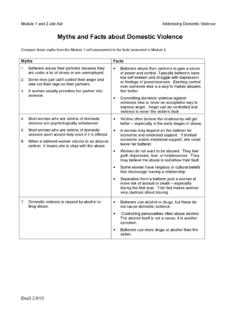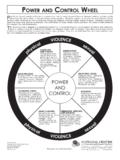Transcription of Domestic violence and abuse and the lesbian, gay, bisexual ...
1 Domestic violence and abuse and the lesbian, gay, bisexual , and transgender ( lgbt ) violence and abuse and the lesbian, gay, bisexual , and transgender ( lgbt ) communitiesThis information sheet answers some questions about what is Domestic violence and abuse and outlines some of the unique aspects and the examples of tactics of Domestic abuse as experienced by lesbian, gay, bisexual and transgender people. If this information sheet doesn t answer your specific question, do give us a call in confidence to talk about your own situation. Contact Galop at: 0207 704 2040 is Domestic violence and abuse ?The UK government defines Domestic violence and abuse as any incident or pattern of incidents of controlling, coercive, threatening behaviour, violence or abuse between those aged 16 or over who are, or have been, intimate partners or family members regardless of gender or sexuality.
2 Domestic violence and abuse can encompass, but is not limited to psychological, physical, sexual, financial and emotional. Controlling behaviour is a range of acts designed to make a person subordinate and/or dependent by isolating them from sources of support, exploiting their resources and capacities for personal gain, depriving them of the means needed for independence, resistance and escape and regulating their everyday behaviour. Coercive behaviour is an act or a pattern of acts of assault, threats, humiliation and intimidation or other abuse that is used to harm, punish, or frighten their violence and abuse is a crime which affects individuals across all cultures, all sexual orientations, all gender identities, all income groups, all ages, and all of tactics of abuse relevant to lgbt communities can encompass, but are not limited to, the following forms: Psychological: threat of disclosing sexual orientation, gender identity, HIV status, or any other personal information to family, employers or friends.
3 Using personal characteristics or circumstances, such as individual s race, age, immigration status, religion, physical ability and/or ethnicity, against them. Physical: pushing, hitting, punching, choking, biting, throwing things, assault with a weapon, withholding medications or hormones, forced substance abuse , hurting pets, damage to property, controlling food intake, stalking, murder. Sexual: unwanted advances, unwanted sexual contact, incest, corrective rape, rape, forcing sex, intentional exposure to HIV or sexually transmitted infections, filming sexual activities and threatening to send the footage to family and friends. Financial: controlling money and resources, forcing partner to pay for most things, forcing partner to live beyond their means, not allowing partner to go to work, taking out loans in the partners name, expecting partner to finance both of their lives.
4 Emotional: name-calling and insults, lying, belittling, and undermining self-esteem, undermining gender identity or sexuality, manipulation, humiliation, blaming, threats of suicide, self-harm, harm to friends, family or pets and intimidation, limiting partner s movement and monitoring whereabouts, depriving them of sleep, exploiting fragile relationships with family because of sexuality or gender identity, belittling their lgbt + experience. Contains information about: Domestic AbuseSexual ViolenceDomestic violence and abuse and the lesbian, gay, bisexual , and transgender ( lgbt ) communities | 2 Domestic abuse also includes so called honour based violence , forced marriage and female genital mutilation. A forced marriage is where one or both people do not consent to the marriage, and pressure or abuse is used. Forced marriage is recognized in the UK as form of violence against men and women, Domestic abuse , child abuse , and is a serious abuse of human based abuse is a crime or incident, which has or may have been committed to protect or defend the honour or the family and/or community.
5 Domestic abuse , can be perpetrated in the home, at workplace, in the public place, via phone and text messages and online. Unique aspects of lgbt Domestic abuseHeterosexual and lgbt people may experience similar patterns of Domestic abuse , there are however some specific issues that are unique to the experiences of lgbt people, which may include: Threat of disclosure of sexual orientation and gender identity to family, friends, or work colleagues. Increased isolation because of factors like lack of family support or safety nets. Undermining someone s sense of gender or sexual identity. Limiting or controlling access to spaces and networks relevant to coming out and coming to terms with gender and sexual identity. The abused may believe they deserve the abuse because of internalised negative beliefs about themselves.
6 The abused may believe that no help is available due to experienced or perceived homo/bi/transphobia of support services and criminal justice specific reference to lgbt partner abuse : Using society s heterosexist myths about aggression and violence abusive partners may manipulate and convince their partner that no one will believe the abuse is real. Abusive partner may manipulate their partners into believing that abuse is a normal part of same-sex relationships. Abusive partners can give the idea that the violence is mutual or that the abused partner consents to the abuse . Abusive partner may threat to call the police and claim they are the abused person. The abusive partner may pressure their partner to minimalise abuse to protect the image of the lgbt community. If the abused partner is living in the UK on a spousal visa, abuser might take advantage of their lack of awareness about immigration law, and threaten to deport them back to their country of origin, which might be unsafe due to : anti-gay legislation.
7 With specific reference to trans persons: Withholding medication or preventing treatment needed to express victim s gender identity ( hormones, surgery). The abuser might refuse to use correct pronouns and prevent the abused from telling other people about their trans background or identity. The abuser might use pejorative names and ridiculing persons body image (body shaming). The abuser might convince or manipulate their partner that nobody would believe them because they re transgender . The abuser might deny a person s access to medical treatment or hormones or coercing them into not pursuing medical violence and abuse and the lesbian, gay, bisexual , and transgender ( lgbt ) communities | 3 Domestic violence and abuse check sheetDoes your partner, former partner, or a family member:о Call you names, humiliate and criticise or belittle you?
8 о Use your gender or sexuality as a basis for threats, intimidation or harm?о Threaten to harm you or others that you love?о Threaten to hurt your pets?о Control your access to money and require you to account in detail for what you spend?о Make unwanted advances or force you into unwanted sexual contact?о Hit, shove, grab, kick, bite, slap, throw things, or use other forms of physical violence on you?о Control or discourage your contact with friends, family, work, or the lgbt scene ?о Emotionally blackmail you and threaten to harm themselves if you leave or seek help?о Limit your movement and monitors your whereabouts?о Accuse you of cheating on them?о Prevent you from working or attend school / education?о Refuse to engage in safe sex?о Blames their drinking or drug use for their abusive behaviour?о Use, or threaten to use, a weapon against you?
9 о Damage your belongings?о Intentionally use the wrong gender pronouns?о Deny you access to medical treatment or hormones?о Monitor your communication with others?о Uses your race, immigration status, physical ability and/or ethnicity, against you?о Pressure or force you into marriage without your consent? Blames you for their behaviour?о Minimises the harm caused by their behaviour?If you answered YES to any of these questions, you may be experiencing Domestic abuse . To explore your options, contact: National lgbt Domestic abuse HelplineT: 0800 999 5428E: London lgbt Domestic abuse PartnershipT: 0207 704 2040E: Always dial 999 if it is an emergency and you think you are in immediate factsheet sheet was funded by the Lloyds Bank Foundation. The content reflects the views of Galop and does not necessarily represent the opinion of Lloyds Banking Foundation.






